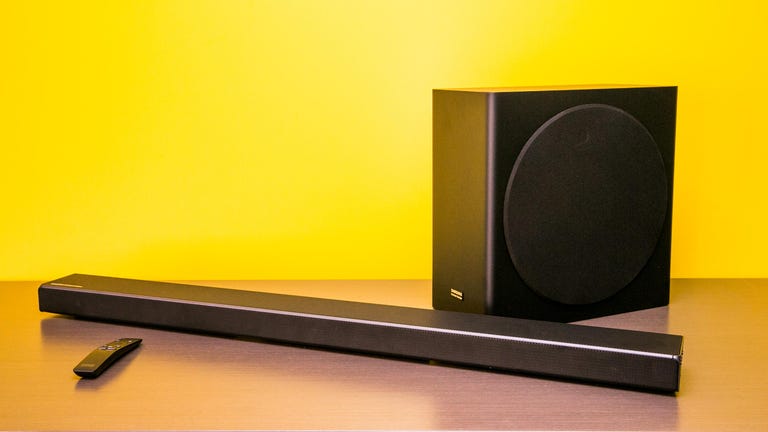 Why You Can Trust CNET
Why You Can Trust CNET Samsung HW-Q70R review: Astounding Atmos surround effects, no rear speakers required
The Samsung HW-Q70R offers a wonderfully enveloping sound from movie soundtracks, but music lovers should look elsewhere.
A few years ago when I took a tour of Samsung's massive California audio lab, I realized the company was serious about sound. Invoking the name of legendary speaker maker B&W, Samsung's Alan Devantier told me his company's simple goal at the time: "When you think of Bowers and Wilkins, you think of Samsung." For their part, B&W representatives recently told me this specific quote is displayed on their meeting room wall.
The Good
The Bad
The Bottom Line
So does the $700 (£799, AU$1,099) HW-Q70R cement Samsung as the successor to the B&W empire? Not quite. It's an engaging performer with attractive looks, but it doesn't compete with B&W when it comes music reproduction. This sound bar, like most of its kind, performs best with movie soundtracks.
The Samsung HW-Q70R includes a subwoofer and Dolby Atmos playback but ditches the extra surround speakers of models like the Vizio SB36514. In my comparison tests I didn't miss them. Perhaps thanks to the wizardry of its audio lab, the Samsung is capable of really impressive faux-surround from just one bar.
The Q70R costs more than the Vizio, but it has a beefier subwoofer and better all-around sound quality. Its closest competitor is the LG SL9, which offers superior features -- namely built-in Google Assistant and Chromecast audio. I like the Samsung a bit better than the LG, however, because of its surround prowess.
Design and features
As usual, Samsung is aligning its soundbars with its TVs -- the implication is you buy a Q70 TV and then get the HW-Q70R soundbar. Done. But of course the HW-Q70R isn't just for Samsung TVs, and its refined appearance should fit within most home setups. Samsung established its current look with the original Atmos soundbar from Samsung's audio lab, the HW-K950 . The Q70R hones the template a little and makes the design more angular, more automotive -- like an intake from a modern Chevy. Unchanged though is the LED display, which is obscured by the grille's lattice and a little hard to read.
The main bar is 43 inches wide, a television-accommodating 2.32 inches high and 3.93 inches deep. Like last year's N650, the Q70R uses a flute-like series of tuned ports to project audio from the top of the speaker and bounce it off your living room walls.
This is a Dolby Atmos sound bar and it brings the dimension of height to your TV and movie soundtracks. It also offers DTS:X playback for those Harry Potter 4K discs in your collection. This is a 3.1.2-channel speaker with a dedicated center channel but no rears included in the box. If you want to add rear speakers, Samsung will sell you the SWA-8500S for a comparatively affordable $129 -- most competitors charge $200 for their rear kits.
The system includes a wireless subwoofer, which is much larger than most at 8 inches wide and roughly 16 inches square. The soundbar includes tuning by Samsung subsidiary Harman Kardon.
The remote is similar to the elegant wand you'll find with the company's high-end televisions with a rocker volume switch plus control over sound mode and input. You can access the settings from here too, but thanks to that speaker's limited display, it's easier to tweak the Q70R using the Smart Things app on your phone.
The soundbar includes an HDMI input (compatible with 4K HDR), ARC HDMI out, digital optical, Bluetooth and Wi-Fi.
It is worth noting that we couldn't get the soundbar to work with one of our test TVs, a 2016 Vizio M-Series, over HDMI -- though all others we tested, including another Vizio, worked well. In addition, some users of the TV have written on Samsung's site that they have had issues with HDMI ARC.
Although it lacks the built-in microphones and onboard voice assistant found on many competitors including the LG SL9 -- no Alexa, Google Assistant or even Bixby here -- it's able to be controlled via a separate Alexa device.
Performance
Samsung might be trying to channel B&W but the Q70R is much better at reproducing movies than music. I found it fine for background music but unsuited to dedicated listening. On the other hand, it was the best of the three Atmos soundbars we tested for movies. Its huge soundstage, produced with just the single speaker and sub, sounded even bigger than that of the Vizio with its dedicated rear speakers.
My listening session started with music, and I was surprised to find the Samsung lacked a sound mode for music or stereo. The Standard mode sounded best for music -- the AD Auto mode sounded way too bright on Joe Jackson's cover of Television's See No Evil. LG SL9 sounded fuller and offered better integration between the sub and the bar.
The Samsung's display can be a little hard to read at times
The Samsung was astonishing with its presentation of Black Hawk Down's surround track, however. Dolby Atmos just should be called "Helicopter Mode." During Chapter 9, three guerrillas attack a Black Hawk helicopter with an RPG, and the Samsung was able to give a great sense of the rocket's trajectory and its booming impact. But the most immersive part was the helicopter sound itself -- the whole room seemed to spin as the soundbar filled the entire front and height of the room. I felt for the American servicemen as they struggled to stay aboard the craft and as Jeremy Piven's character struggled to keep it from plunging directly into the ground.
While the LG sounded better than the Vizio on this title, neither were able to capture the vertiginous feelings that the Samsung generated. The Samsung's dialog sounded slightly recessed in default settings but I was able to fix the issue by bumping up the center channel volume control.
Should you buy it?
While few soundbars can do both music and movies well, even fewer sound as good as the Samsung for movies. While its feature set lags behind the LG SL9, it performs better for Atmos soundtracks, making it the superior choice if you don't care about having an integrated voice assistant. I like the Vizio best among the three because of its incredible value, but both Korean speakers make strong cases for buyers willing to spend a bit more.


